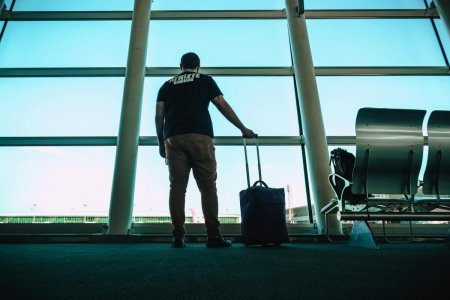TSA update: 11 items you can now bring in your carry-on—no size limits needed (at some airports)
By
Veronica E.
- Replies 0
If you’ve ever struggled to fit your favorite lotion or medication into a tiny travel-sized bottle, you're not alone.
For years, travelers have had to make tough packing choices—especially when it came to carry-on liquids.
But that might be changing soon.
The Transportation Security Administration (TSA) is introducing a major update that could make travel a little more convenient for everyone, especially for those who rely on full-size medical supplies or travel with little ones.
Whether you're planning a cross-country trip or visiting family for the holidays, these changes might help you pack with a little less stress—and a bit more peace of mind.

Since 2006, travelers have followed the well-known 3.4-ounce liquid rule, using quart-sized bags to pack toiletries and medications.
This was part of a broader effort to ensure safety in the skies.
Now, thanks to improved screening technology, some airports in the United States are easing that restriction—at least for certain items.
The TSA is currently testing new computed tomography (CT) scanners that offer detailed 3D images of carry-on bags.
These scanners give security officers a much clearer look inside your luggage, which in turn allows them to permit larger volumes of previously restricted items.
Here are 11 items that travelers can now bring in full-size form at select airports:
These changes are especially helpful for parents and those managing health conditions. Even aquarium enthusiasts can now travel with their live fish—with proper care, of course.
It’s important to know this isn’t a nationwide change—yet.
The updated screening is only being rolled out at select airports, including Atlanta (ATL), New York’s JFK, and Los Angeles (LAX).
If you're not flying out of one of these locations, you'll still need to follow the usual 3.4-ounce rule.
Also keep in mind that international airports may have different policies, so always double-check with your airline and destination airport before flying.
The TSA still advises packing smaller sizes whenever possible, just in case.
To avoid any surprises at the checkpoint, TSA recommends using their app, which includes a helpful “What can I bring?” feature.
This tool lets you quickly check what’s allowed based on your departure airport.
You can also reach out to TSA through social media if you have specific questions.
A good tip from TSA federal security director Christopher Murgia: “Start with an empty bag” when packing.
This helps prevent accidentally bringing along anything restricted.
These changes could offer some much-needed flexibility for travelers—especially seniors who often travel with specific health items or prefer a more relaxed packing routine.
While it’s not yet available everywhere, it’s a promising shift toward making travel more convenient without compromising safety.
Read next: Major disruption at airport throws travel plans into disarray–Here’s what we know.

We’d love to hear from you! Do you think these updates will make a difference in your travel experience? Have any packing tips to share with fellow readers? Leave your thoughts in the comments below.
For years, travelers have had to make tough packing choices—especially when it came to carry-on liquids.
But that might be changing soon.
The Transportation Security Administration (TSA) is introducing a major update that could make travel a little more convenient for everyone, especially for those who rely on full-size medical supplies or travel with little ones.
Whether you're planning a cross-country trip or visiting family for the holidays, these changes might help you pack with a little less stress—and a bit more peace of mind.

New TSA screening technology may soon let travelers pack full-size essentials—making trips a bit easier for parents, seniors, and frequent flyers. Image Source: Pexels / Victor Freitas.
A shift in security screening
Since 2006, travelers have followed the well-known 3.4-ounce liquid rule, using quart-sized bags to pack toiletries and medications.
This was part of a broader effort to ensure safety in the skies.
Now, thanks to improved screening technology, some airports in the United States are easing that restriction—at least for certain items.
The TSA is currently testing new computed tomography (CT) scanners that offer detailed 3D images of carry-on bags.
These scanners give security officers a much clearer look inside your luggage, which in turn allows them to permit larger volumes of previously restricted items.
What items are included?
Here are 11 items that travelers can now bring in full-size form at select airports:
- Over-the-counter medications
- Prescription medications in liquid, gel, or aerosol form
- Ice packs or gel packs for medical use
- Food and drinks for infants and toddlers
- Wet batteries
- Live fish transported in water
- Biological specimens
- Breast milk and baby formula
- Liquid-filled teethers
- Duty-free liquids in tamper-evident packaging
- Fresh eggs
These changes are especially helpful for parents and those managing health conditions. Even aquarium enthusiasts can now travel with their live fish—with proper care, of course.
Also read: Travelers take note: Why New York's latest health alert may change your travel plans
Not at every airport (yet)
It’s important to know this isn’t a nationwide change—yet.
The updated screening is only being rolled out at select airports, including Atlanta (ATL), New York’s JFK, and Los Angeles (LAX).
If you're not flying out of one of these locations, you'll still need to follow the usual 3.4-ounce rule.
Also keep in mind that international airports may have different policies, so always double-check with your airline and destination airport before flying.
The TSA still advises packing smaller sizes whenever possible, just in case.
Also read: Travel nightmare: Lost or stolen license? You never know when this might happen.
To avoid any surprises at the checkpoint, TSA recommends using their app, which includes a helpful “What can I bring?” feature.
This tool lets you quickly check what’s allowed based on your departure airport.
You can also reach out to TSA through social media if you have specific questions.
A good tip from TSA federal security director Christopher Murgia: “Start with an empty bag” when packing.
This helps prevent accidentally bringing along anything restricted.
These changes could offer some much-needed flexibility for travelers—especially seniors who often travel with specific health items or prefer a more relaxed packing routine.
While it’s not yet available everywhere, it’s a promising shift toward making travel more convenient without compromising safety.
Read next: Major disruption at airport throws travel plans into disarray–Here’s what we know.
Key Takeaways
- TSA has announced that with the installation of new CT scanners at certain airports, they will lift size restrictions on 11 different types of items in carry-on bags.
- The new 3D imaging technology of these scanners allows for full-sized items to be more thoroughly assessed for threats, potentially including over-the-counter medications, prescription medicines, wet batteries, and several other specific items.
- While the new rules are being tested at airports including Atlanta, JFK, and LAX, other airports still enforce the traditional 3.4-ounce liquid limit.
- Despite the updates, TSA recommends that travelers continue to follow the 3.4-ounce rule to ensure smooth transit through all airports, and offers a TSA app with a "What can I bring?" feature for checking restrictions.
We’d love to hear from you! Do you think these updates will make a difference in your travel experience? Have any packing tips to share with fellow readers? Leave your thoughts in the comments below.






